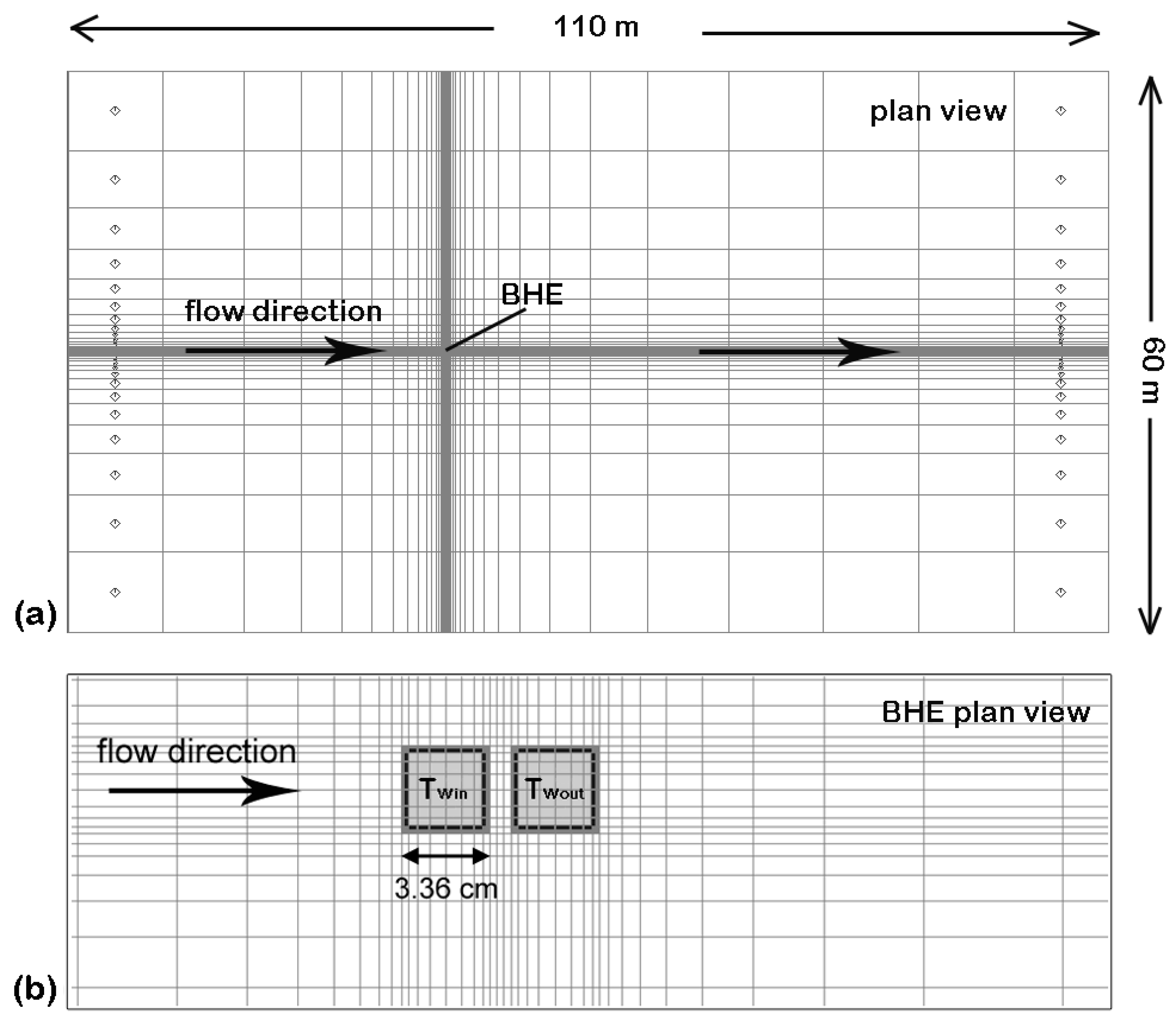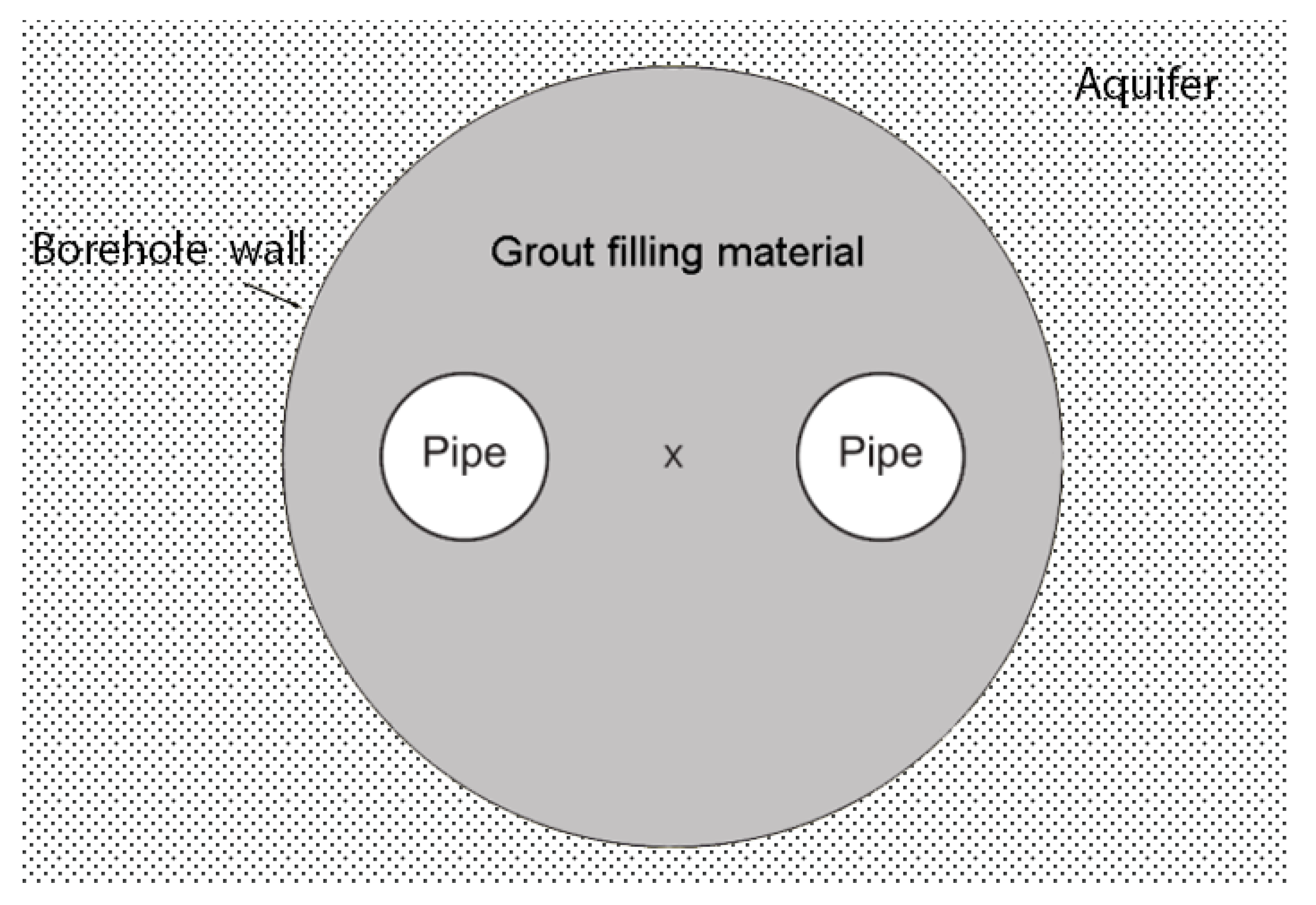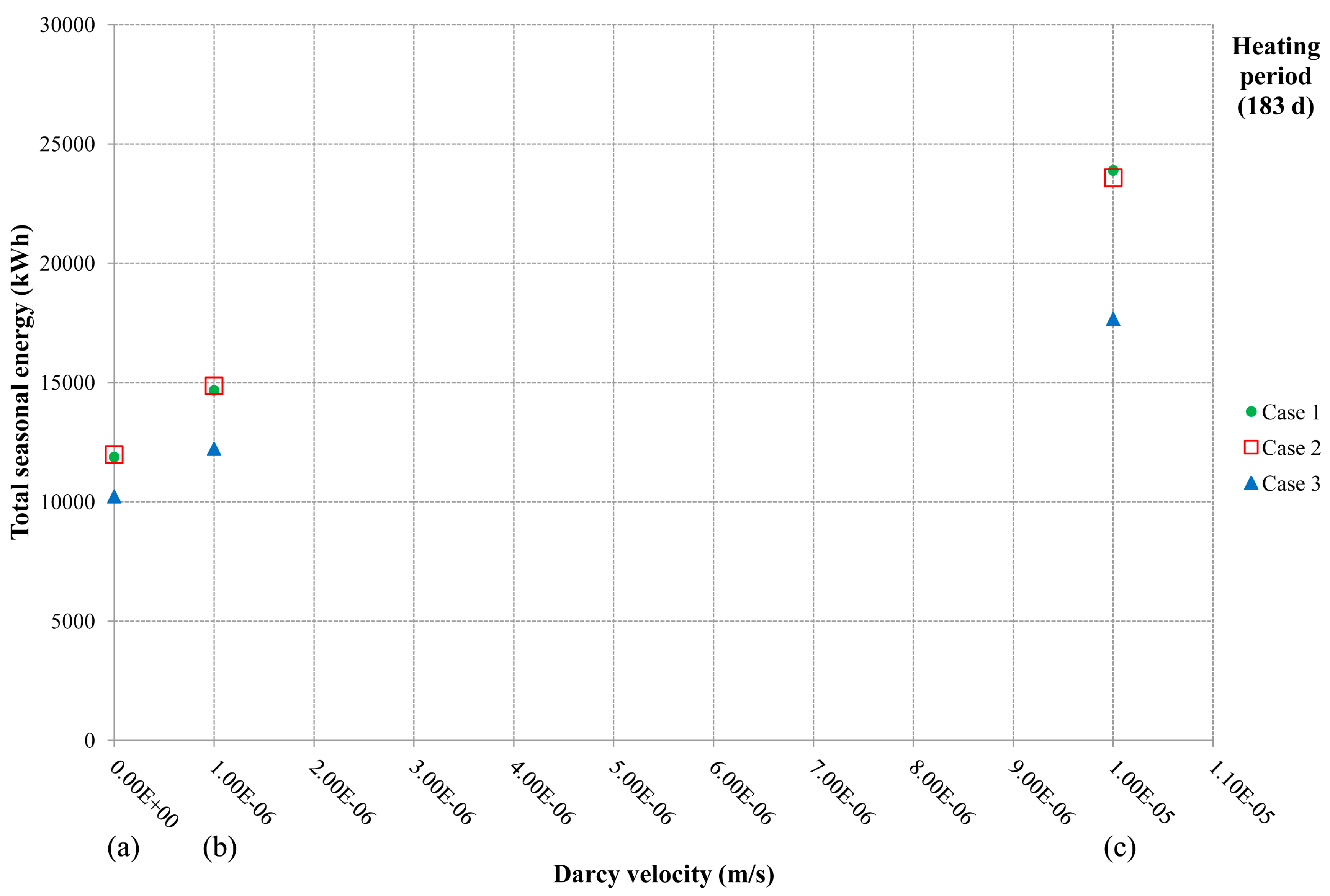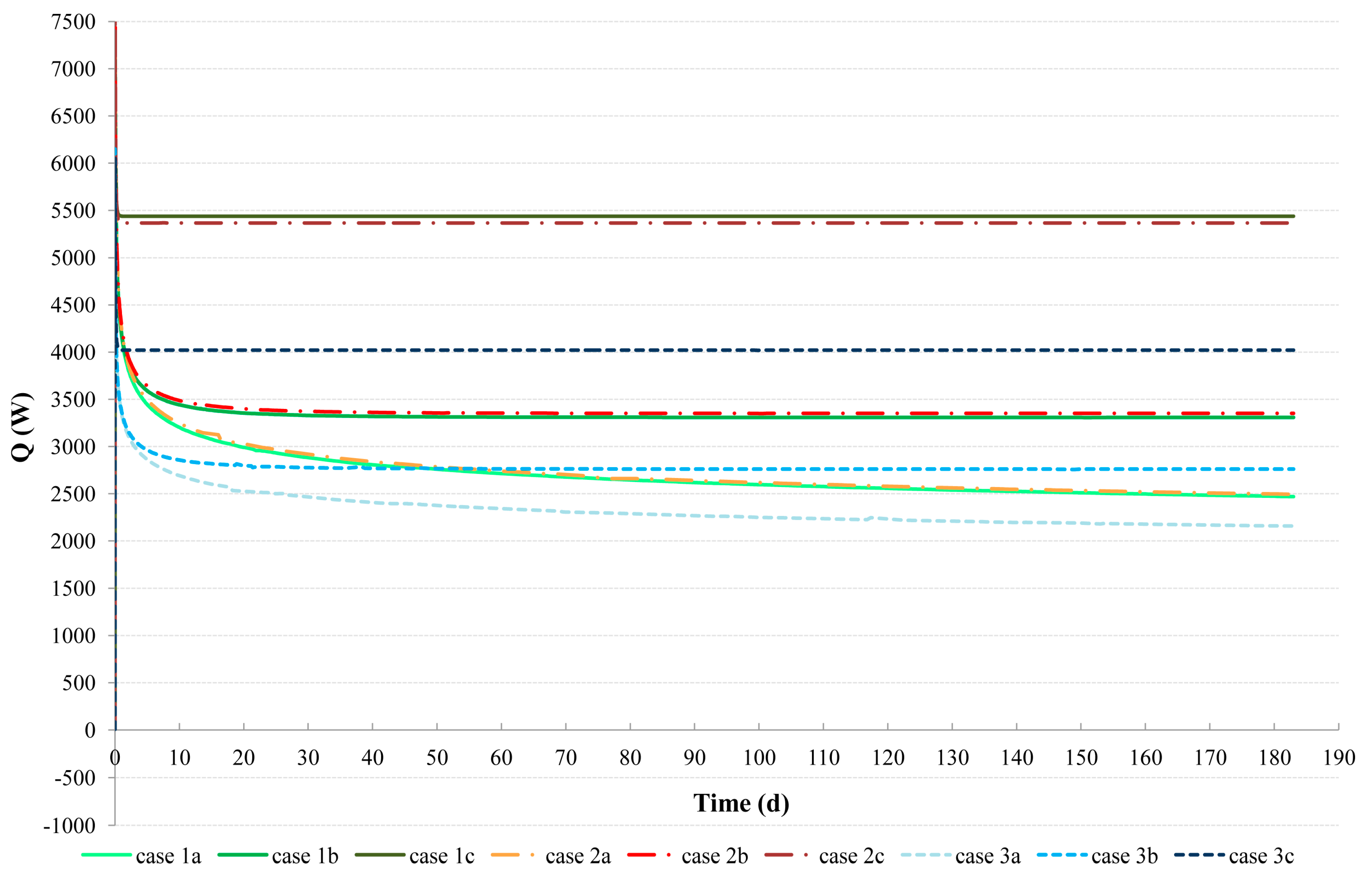A Numerical Study on the Impact of Grouting Material on Borehole Heat Exchangers Performance in Aquifers
Abstract
:1. Introduction
2. Heat and Mass Transport Equations
3. Model Implementation
Grout Implementation
- (1)
- the surrounding aquifer material;
- (2)
- a thermally enhanced grout with a thermal conductivity equal to the surrounding soil;
- (3)
- a poor grout with a low thermal conductivity.
4. Simulation Results
- From the modeling perspective, these results indicate that when the grout has a thermal conductivity equal or near to the surrounding ground, neglecting the grouting material in the numerical model does not lead to relevant errors, even at important Darcy velocities. On the contrary, when the grouting material has a poor thermal conductivity compared to the surrounding ground, it is necessary to represent the grout in the numerical model because neglecting it leads to significantly overestimate the BHE performance. Moreover, this study specifically shows that the overestimation increases with Darcy velocity.
- From the BHE design perspective, these results indicate that adopting a high thermal conductivity grout is even more important at high Darcy velocities, since it further enhances the benefits of the advective transport in the surrounding aquifer. Furthermore it arises that reducing the environmental risk of heat carrier fluid leakages by adopting a grout in the borehole does not affect significantly the BHE performances (see Table 4, the maximum seasonal energy decrease is −1.3%). The negligible decrease is due to the low hydraulic conductivity in the neighborhood of the pipes.
- From the environmental perspective it is interesting to assess the possible impact of the grout on the temperature distribution in the subsoil. The cold thermal perturbation generated in the aquifer at the end of the winter BHE operational period is then shown in Figure 6 for the three considered velocities and the three grouting cases. The Figure 6 shows the ground temperature distribution across the BHE along the longitudinal groundwater flow direction approximately at half the BHE depth. It is worth noting that, since in the model the inlet pipe is positioned exactly upstream while the outlet pipe is downstream, the curves are not symmetrical, even in the null velocity condition. The latter absence of symmetry was already remarked by several authors, e.g., Kramer et al. [41].
5. Conclusions
Author Contributions
Conflicts of Interest
Nomenclature
| Symbol | Variable | Unit |
| BHE | Borehole Heat Exchanger | - |
| Cm, Cw, Cp | Volumetric heat capacity of the porous medium or water or pipe | J/(m3·K) |
| Ck | Dissolved mass concentration | kg/m3 |
| Cs | Concentration of the sources or sinks | kg/m3 |
| cps, cpw, cpf | Specific heat capacity of the solid or water or fluid | J/(kg·K) |
| D* | Molecular diffusion coefficient/Thermal diffusion coefficient | m2/s |
| Dij | Diffusion-dispersion tensor | m2/s |
| d, dp | Dispersivity coefficient of the porous medium or pipe | m |
| E | Exchanged energy by BHE | kWh |
| θ, θp | Volumetric water content of the porous medium or pipe | - |
| GSHP | Ground Source Heat Pump | - |
| H, h | Hydraulic head | m |
| km, kg, kp | Hydraulic conductivity of the porous medium or grout or pipe | m/s |
| Kd | Distribution coefficient | m3/kg |
| λm | Effective thermal conductivity of the porous medium | W/(m·K) |
| λg, λs, λw, λp | Thermal conductivity of the grout or solid or water or pipe | W/(m·K) |
| I | Identity tensor | - |
| L | Side of the pipe represented by square section | m |
| Mass flow rate at time i | kg/s | |
| π | Energy source/sink rate per unit volume | W/m3 |
| qi | Heat rate per unit length or specific heat rate | W/m |
| qs | Volumetric flow rate per unit volume of aquifer representing sources and sinks | (m3/s)/m2 |
| qt | Heat flux | W/m2 |
| Rbh, Rg | Borehole or ground thermal resistance per unit length | m·K/W |
| ρb | Porous medium bulk density | kg/m3 |
| ρs, ρw | Density of the solid material or water | kg/m3 |
| sp | Thickness of the pipe | m |
| T, Ts, Tg0 | Temperature, temperature of the source or undisturbed ground | K |
| Tfi, Tfo, Tfm | Inlet, outlet or average temperature of the heat carrier fluid | K |
| t | Time | s |
| vi | Groundwater Darcy velocity | m/s |
| xi, xj | Space coordinates along directions i and j | m |
| z | Borehole depth | m |
References
- Angelotti, A.; Alberti, L.; Antelmi, M.; Formentin, G.; Legrenzi, C. Zoo-technical application of ground source heat pumps: A pilot case study. In Proceedings of the 12th REHVA World Congress 2016 (CLIMA 2016), Aalborg, Denmark, 22–25 May 2016. [Google Scholar]
- Alcarez, M.; Garcìa-Gil, A.; Vázquez-Suñé, E.; Velasco, V. Advection and dispersion heat transport mechanisms in the quantification of shallow geothermal resources and associated environmental impacts. Sci. Total Environ. 2016, 543, 536–546. [Google Scholar] [CrossRef] [PubMed]
- Somogyi, V.; Sebestyén, V.; Domokos, E.; Zseni, A.; Papp, Z. Thermal impact assessment with hydrodynamics and transport modelling. Energy Convers. Manag. 2015, 104, 127–134. [Google Scholar] [CrossRef]
- Zheng, C.; Wang, P.P. MT3DMS: A Modular Three-Dimensional Transport Model for Simulation of Advection, Dispersion and Chemical Reactions of Contaminants in Groundwater Systems; Documentation and User’s Guide; Contract Report SERDP-99-1; US Army Engineer Research and Development Center: Vicksburg, MS, USA, 1999. [Google Scholar]
- Diersch, H.J.G. FEFLOW Reference Manual; WASY GmbH Institute for Water Resources Planning and Systems Research Ltd.: Berlin, Germany, 2002; p. 278. [Google Scholar]
- Angelotti, A.; Alberti, L.; La Licata, I.; Antelmi, M. Energy performance and thermal impact of a borehole heat exchanger in a sandy aquifer: Influence of the groundwater velocity. Energy Convers. Manag. 2014, 77, 700–708. [Google Scholar] [CrossRef]
- Mogensen, P. Fluid to duct wall heat transfer in duct system heat storage. In Proceedings of the International Conference on Surface Heat Storage in Theory and Practice, Stockholm, Sweden, 6–8 June 1983; pp. 652–657. [Google Scholar]
- Zeng, H.; Diao, N.; Fang, Z. Heat transfer analysis of boreholes in vertical ground heat exchangers. Int. J. Heat Mass Transf. 2003, 46, 4467–4481. [Google Scholar] [CrossRef]
- Chang, K.S.; Kim, M.J. Thermal performance evaluation of vertical U-loop ground heat exchanger using in-situ thermal response test. Renew. Energy 2016, 87, 585–591. [Google Scholar] [CrossRef]
- Casasso, A.; Sethi, R. Efficiency of closed loop geothermal heat pumps: A sensitivity analysis. Renew. Energy 2014, 62, 737–746. [Google Scholar] [CrossRef]
- Wołoszyn, J.; Gołas, A. Sensitivity analysis of efficiency thermal energy storage on selected rock mass and grout parameters using design of experiment method. Energy Convers. Manag. 2014, 87, 1297–1304. [Google Scholar] [CrossRef]
- Casasso, A.; Sethi, R.G. POT: A quantitative method for the assessment and mapping of the shallow geothermal potential. Energy 2016, 106, 765–773. [Google Scholar] [CrossRef]
- Hein, P.; Kolditz, O.; Görke, U.J.; Bucher, A.; Shao, H. A numerical study on the sustainability and efficiency of borehole heat exchanger coupled ground source heat pump systems. Appl. Therm. Eng. 2016, 100, 421–433. [Google Scholar] [CrossRef]
- Allan, M.; Philippacopoulos, A. Performance characteristics and modelling of cementitious grouts for geothermal heat pumps. In Proceedings of the World Geothermal Congress, Kyushu, Tohoku, Japan, 28 May–10 June 2000. [Google Scholar]
- Alrtimi, A.A.; Rouainia, M.; Manning, D.A.C. Thermal enhancement of PFA-based grout for geothermal heat exchangers. Appl. Therm. Eng. 2013, 54, 559–564. [Google Scholar] [CrossRef]
- Erol, S.; François, B. Freeze damage of grouting materials for borehole heat exchanger: Experimental and analytical evaluations. Geomech. Energy Environ. 2016, 5, 29–41. [Google Scholar] [CrossRef]
- Hellström, G. Thermal performance of borehole heat exchangers. In Proceedings of the Second Stockton International Geothermal Conference, Galloway, NJ, USA, 16–17 March 1998. [Google Scholar]
- Wagner, V.; Bayer, P.; Kübert, M.; Blum, P. Numerical sensitivity study of thermal response tests. Renew. Energy 2012, 41, 245–253. [Google Scholar] [CrossRef]
- Witte, H.J.L. A parametric sensitivity study into borehole performance design parameters. In Proceedings of the 12th International Conference on Energy Storage, Lleida, Spain, 16–18 May 2012. [Google Scholar]
- Dehkordi, S.E.; Schincariol, R.A. Effect of thermal-hydrogeological and borehole heat exchanger properties on performance and impact of vertical closed-loop geothermal heat pump systems. Hydrogeol. J. 2014, 22, 189–203. [Google Scholar] [CrossRef]
- Ghasemi-Fare, O.; Basu, P. Predictive assessment of heat exchanger performance of geothermal piles. Renew. Energy 2016, 86, 1178–1196. [Google Scholar] [CrossRef]
- Delaleux, F.; Py, X.; Olives, R.; Dominguez, A. Enhancement of geothermal borehole heat exchangers performances by improvement of bentonite grouts conductivity. Appl. Therm. Eng. 2012, 33–34, 92–99. [Google Scholar] [CrossRef]
- Jun, L.; Xu, Z.; Jun, G.; Jie, Y. Evaluation of heat exchange rate of GHE in geothermal heat pump systems. Renew. Energy 2009, 34, 2898–2904. [Google Scholar] [CrossRef]
- Lee, C.; Lee, K.; Choi, H.; Choi, H.P. Characteristics of thermally-enhanced bentonite grouts for geothermal heat exchanger in South Korea. Sci. China Technol. Sci. 2010, 53, 123–128. [Google Scholar] [CrossRef]
- Hecht-Méndez, J.; De Paly, M.; Beck, M.; Bayer, P. Optimization of energy extraction for vertical closed-loop geothermal systems considering groundwater flow. Energy Convers. Manag. 2013, 66, 1–10. [Google Scholar] [CrossRef]
- Angelotti, A.; Alberti, L.; La Licata, I.; Antelmi, M. Borehole heat exchangers: Heat transfer simulation in the presence of a groundwater flow. J. Phys. Conf. Ser. 2014, 501, 012033. [Google Scholar] [CrossRef]
- Munoz, M.; Garat, P.; Flores-Aqueveque, V.; Vargas, G.; Rebolledo, S.; Sepúlveda, S.; Daniele, L.; Morata, D.; Parada, M.A. Estimating low-enthalpy geothermal energy potential for district heating in Santiago basine Chile (33.5 °S). Renew. Energy 2015, 76, 186–195. [Google Scholar] [CrossRef]
- Rivera, J.A.; Blum, P.; Bayer, P. Analytical simulation of groundwater flow and land surface effects on thermal plumes of borehole heat exchangers. Appl. Energy 2015, 146, 421–433. [Google Scholar] [CrossRef]
- Wagner, V.; Blum, P.; Kübert, M.; Bayer, P. Analytical approach to groundwater-influenced thermal response tests of grouted borehole heat exchangers. Geothermics 2013, 46, 22–31. [Google Scholar] [CrossRef]
- Vettorello, L.; Pedron, R.; Sottani, A.; Chieco, M. Heat exchange modeling in a multilayered karst aquifer affected by seawater intrusion. Acque Sotterr. Ital. J. Groundw. 2015, 4, 25–35. [Google Scholar] [CrossRef]
- Sàez Blázquez, C.; Farfán Martín, A.; Martín Nieto, I.; Carrasco García, P.; Sánchez Pérez, L.S.; González-Aguilera, D. Efficiency analysis of the main components of a vertical closed-loop system in a borehole heat exchanger. Energies 2017, 10, 201. [Google Scholar] [CrossRef]
- McDonald, M.G.; Harbaugh, A.W. Programmer’s Documentation for MODFLOW-96, an Update to the U.S. Geological Survey Modular Finite-difference Groundwater Flow Model; U.S. Geological Survey Open-File Report 96-486; U.S. Geological Survey: Reston, VA, USA, 1996; pp. 1–228.
- Harbaugh, A.W.; Banta, E.R.; Hill, M.C.; McDonald, M.G. MODFLOW-2000, the US Geological Survey Modular Ground-Water Model—User Guide to Modularization Concepts and the Ground-Water Flow Process; U.S. Geological Survey Open-File Report 00-92; U.S. Geological Survey: Reston, VA, USA, 2000; pp. 1–127.
- Thorne, D.; Langevin, C.D.; Sukop, M.C. Addition of simultaneous heat and solute transport and variable fluid viscosity to SEAWAT. Comput. Geosci. 2006, 32, 1758–1768. [Google Scholar] [CrossRef]
- Alberti, L.; Alimi, H.; Ertel, T.; Trefiletti, P.; Pietrini, I. Fingerprinting and groundwater model application to evaluate hydraulic barrier efficiency (Italy). Environ. Forensics 2015, 16, 217–230. [Google Scholar] [CrossRef]
- Alberti, L.; Cantone, M.; Colombo, L.; Lombi, S.; Pianan, A. Numerical modeling of regional groundwater flow in the AddaTicino Basin: Advances and new results. Rend. Online Della Soc. Geol. Ital. 2016, 41, 10–13. [Google Scholar] [CrossRef]
- Chiasson, A.; Rees, J.; Spitler, J. A preliminary assessment of the effects of groundwater flow on closed-loop ground-source heat pump systems. ASHRAE Trans. 2000, 106, 380–393. [Google Scholar]
- Hecht-Mendez, J.; Molina-Giraldo, N.; Blum, P.; Bayer, P. Evaluating MT3DMS for heat transport simulation of closed geothermal systems. Groundwater 2010, 5, 741–756. [Google Scholar] [CrossRef] [PubMed]
- Spitler, J.D. GLHEPRO—A design tool for commercial building ground loop heat exchangers. In Proceedings of the Fourth International Heat Pumps in Cold Climates Conference, Aylimer, QC, Canada, 17–18 August 2000. [Google Scholar]
- Heat Pump Geothermal Systems. Design and Sizing Requirements; UNI 11466; UNI: Milano, Italy, 2012.
- Kramer, C.; Ghasemi-Fare, O.; Basu, P. Laboratory thermal performance tests on a model heat exchanger pile in sand. Geotech. Geol. Eng. 2015, 33, 253–271. [Google Scholar] [CrossRef]







| Porosity | θ | 0.35 |
|---|---|---|
| Dispersivity | d | 0 m |
| Effective thermal conductivity | λm | 2.3 W/(m·K) |
| Volumetric thermal capacity | Cm | 2.72 MJ/(m3·K) |
| Hydraulic conductivity | km | 2 × 10−4 m/s |
| Darcy velocities | vi | 0; 10−6; 10−5 m/s |
| Porosity | θp | 0.02 |
|---|---|---|
| Dispersivity | dp | 0 m |
| Thermal conductivity | λp | 0.38 W/(m·K) |
| Volumetric thermal capacity | Cp | 1.78 MJ/(m3·K) |
| Hydraulic conductivity | kp | 1 × 10−21 m/s |
| Simulated Cases | Darcy Velocity (m/s) | ||||||||
|---|---|---|---|---|---|---|---|---|---|
| Grout Type | Case | Back-Filling | λg (W·m−1 K−1) | kg (m/s) | θ | Rbh (m·K/W) | a | b | c |
| 1 | Ground | 2.3 | 2 × 10−4 | 0.35 | 0.0540 | 0 | 1 × 10−6 | 1 × 10−5 | |
| 2 | High thermal conductivity grout | 2.3 | 5 × 10−11 | 0.2 | 0.0540 | 0 | 1 × 10−6 | 1 × 10−5 | |
| 3 | Low thermal conductivity grout | 0.7 | 5 × 10−11 | 0.2 | 0.1354 (+151%) | 0 | 1 × 10−6 | 1 × 10−5 | |
| Total Seasonal Energy (kWh) | Percentage Differences (%) | ||||
|---|---|---|---|---|---|
| Case | 1 | 2 | 3 | Case 2 vs. 1 | Case 3 vs. 1 |
| a | 11,871.6 | 11,979.1 | 10,220.2 | 0.9 | −13.9 |
| b | 14,666.9 | 14,858.7 | 12,226.1 | 1.3 | −16.6 |
| c | 23,888.8 | 23,579.9 | 17,661.9 | −1.3 | −26.1 |
© 2017 by the authors. Licensee MDPI, Basel, Switzerland. This article is an open access article distributed under the terms and conditions of the Creative Commons Attribution (CC BY) license (http://creativecommons.org/licenses/by/4.0/).
Share and Cite
Alberti, L.; Angelotti, A.; Antelmi, M.; La Licata, I. A Numerical Study on the Impact of Grouting Material on Borehole Heat Exchangers Performance in Aquifers. Energies 2017, 10, 703. https://doi.org/10.3390/en10050703
Alberti L, Angelotti A, Antelmi M, La Licata I. A Numerical Study on the Impact of Grouting Material on Borehole Heat Exchangers Performance in Aquifers. Energies. 2017; 10(5):703. https://doi.org/10.3390/en10050703
Chicago/Turabian StyleAlberti, Luca, Adriana Angelotti, Matteo Antelmi, and Ivana La Licata. 2017. "A Numerical Study on the Impact of Grouting Material on Borehole Heat Exchangers Performance in Aquifers" Energies 10, no. 5: 703. https://doi.org/10.3390/en10050703







